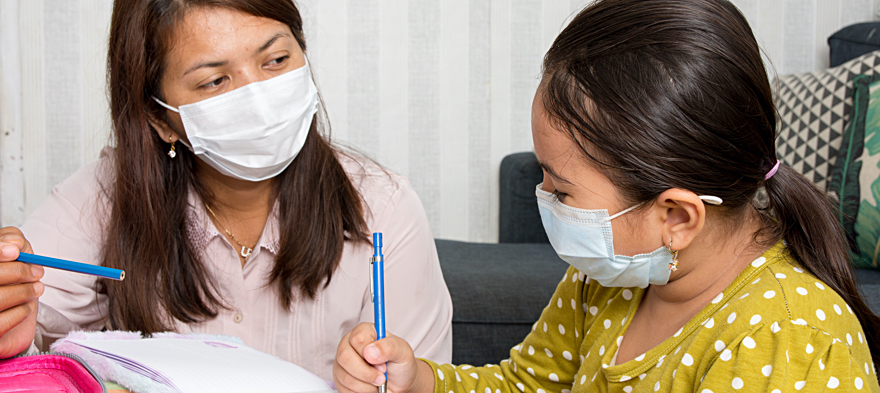
Aug 6, 2020 12:00:00 AM
by Jodi Grant
These are scary times. I’m navigating an elderly mom afraid to leave her house, two socially isolated kids struggling to learn on their own, and a job with a workload that has increased, not decreased. It isn’t easy, but I am lucky.
Beyond my own home—at work—I am trying to ease the pain of children whose parents worry about putting food on the table, getting evicted, and losing their jobs, while fearful of getting sick or watching a loved one get sick—or worse. Add in police murdering unarmed citizens and our government tear-gassing peaceful demonstrators. This is a horrible time to be a child.
[pullquote]As concerned as I am about academic losses, I am much more worried about the mental health of an entire generation.[/pullquote] Our kids need to feel emotionally and physically safe to learn. They need to interact with other children and caring adults. Economic recovery depends on that, too, since parents cannot return to work unless they know their children are safe, learning and engaged.
The truth is, public health concerns mean few schools will re-open with business as usual this fall. School boards are working with unnecessarily limited choices, because they keep making a heartbreaking, false assumption: That students can only learn in a school classroom or at home.
There are other options. My organization, the Afterschool Alliance, has released a blueprint showing how schools and out-of-school time programs can partner to help weary working parents and children starving for face-to-face time with friends and mentors.
We can create hubs where children can learn both virtually and in person. We already know where to do this. Parks and recs, libraries, museums, historical sites, unused college campuses, malls, science centers, public housing, empty office space and more can become hubs for students. Summer camps and child care programs for essential workers have followed guidelines, including these from the American Camp Association, to keep children and parents safe.
We also already know who can partner to staff these places. I’m proud to be part of the out-of-school time field. We are the people who mentor youth and enrich their minds, bodies and spirits when school is not in session. We can be found in non-profit, for-profit and faith-based organizations. If we work hand-in-hand with teachers, we can stem learning loss and support children emotionally. Most importantly, [pullquote position="right"]we can provide places where kids can connect with each other.[/pullquote]
At the heart of this plan are hubs with small groups of students, supervised by the same adult(s) every day. If someone in a “pod” gets sick or is exposed, we can shut it down without disrupting other students.
Creative thinkers are trying to create just such learning ecosystems:
For such solutions to work on a larger scale, programs will need to provide resources to children all day when school is virtual or staggered. Communities can tap college students, recently unemployed adults, and service programs like AmeriCorps. The curriculum exists and seasoned out-of-school educators at science centers, museums and historic sites can help with professional development. There’s a free application called Mizzen, created by the Mott Foundation, that can be used for curriculum and training.
For most kids, mine included, learning on your own is far from ideal, even if you have the resources you need. But [pullquote]the pandemic has exacerbated a much more serious problem: Brutal inequities in our education system.[/pullquote] Many kids lack access to the Internet, a home computer, or a space to learn virtually.
Wealthier parents are hiring teachers and tutors to help their kids learn in person or in small pods. Tutoring can cost $100 an hour. For-profit facilities that once served kids after school are opening all day. Private schools are inundated with applications. Sadly, these options are only available for those who can afford them.
We can bridge this gap, but it will take time, space, staff and resources. We estimate the cost at about $6.2 billion, and have called on Congress to include such funding in the COVID relief package now stalled in the Senate.
We need to meet the individual learning and emotional needs of all students by teaching them in small groups, while making it easier for parents to get back to work, either virtually or in person, so our economy can recover. Unless we seize this moment, the economic and human loses will be staggering but, conversely, a short-term investment now will pay off for years.
Jodi Grant has been executive director of the Afterschool Alliance, a nonprofit public awareness and advocacy organization working to ensure that all children and youth have access to quality, affordable after-school programs since 2005. Before joining the Afterschool Alliance, Grant served as director of Work and Family Programs for the National Partnership for Women & Families. Grant graduated from Yale University with honors and received her law degree from Harvard University, and she discovered her passion for afterschool while volunteering at a program as a college student.
The story you tell yourself about your own math ability tends to become true. This isn’t some Oprah aphorism about attracting what you want from the universe. Well, I guess it kind of is, but...
If you have a child with disabilities, you’re not alone: According to the latest data, over 7 million American schoolchildren — 14% of all students ages 3-21 — are classified as eligible for special...
The fight for educational equity has never been just about schools. The real North Star for this work is providing opportunities for each child to thrive into adulthood. This means that our advocacy...
Your donations support the voices who challenge decision makers to provide the learning opportunities all children need to thrive.
Ed Post is the flagship website platform of brightbeam, a 501(c3) network of education activists and influencers demanding a better education and a brighter future for every child.
© 2020–2024 brightbeam. All rights reserved.
Leave a Comment